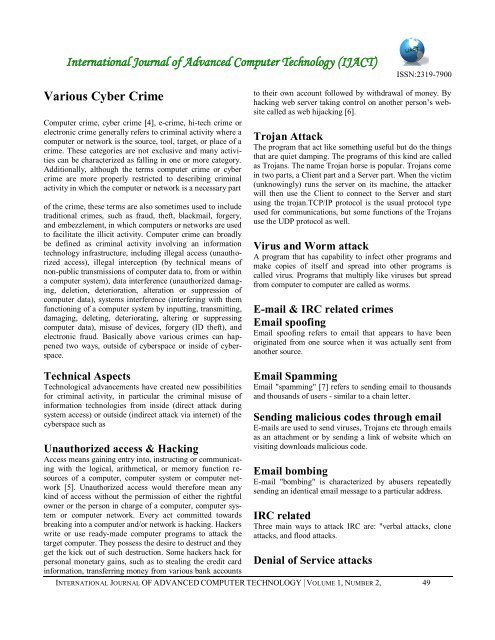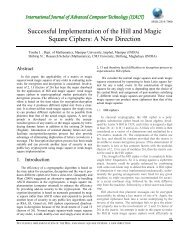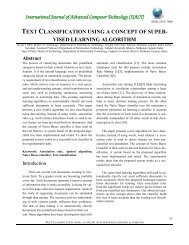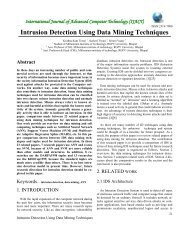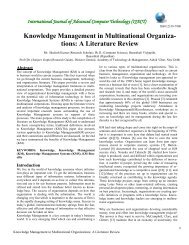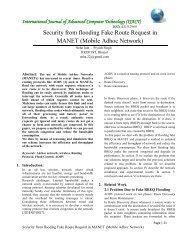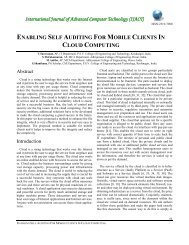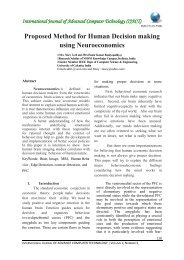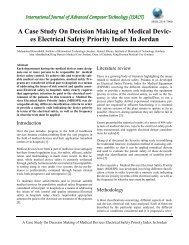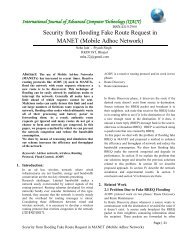A survey of Indian Cyber crime and law and its pre- vention approach
A survey of Indian Cyber crime and law and its pre- vention approach
A survey of Indian Cyber crime and law and its pre- vention approach
Create successful ePaper yourself
Turn your PDF publications into a flip-book with our unique Google optimized e-Paper software.
International Journal <strong>of</strong> Advanced Computer Technology (IJACT)ISSN:2319-7900Various <strong>Cyber</strong> CrimeComputer <strong>crime</strong>, cyber <strong>crime</strong> [4], e-<strong>crime</strong>, hi-tech <strong>crime</strong> orelectronic <strong>crime</strong> generally refers to criminal activity where acomputer or network is the source, tool, target, or place <strong>of</strong> a<strong>crime</strong>. These categories are not exclusive <strong>and</strong> many activitiescan be characterized as falling in one or more category.Additionally, although the terms computer <strong>crime</strong> or cyber<strong>crime</strong> are more properly restricted to describing criminalactivity in which the computer or network is a necessary part<strong>of</strong> the <strong>crime</strong>, these terms are also sometimes used to includetraditional <strong>crime</strong>s, such as fraud, theft, blackmail, forgery,<strong>and</strong> embezzlement, in which computers or networks are usedto facilitate the illicit activity. Computer <strong>crime</strong> can broadlybe defined as criminal activity involving an informationtechnology infrastructure, including illegal access (unauthorizedaccess), illegal interception (by technical means <strong>of</strong>non-public transmissions <strong>of</strong> computer data to, from or withina computer system), data interference (unauthorized damaging,deletion, deterioration, alteration or sup<strong>pre</strong>ssion <strong>of</strong>computer data), systems interference (interfering with themfunctioning <strong>of</strong> a computer system by inputting, transmitting,damaging, deleting, deteriorating, altering or sup<strong>pre</strong>ssingcomputer data), misuse <strong>of</strong> devices, forgery (ID theft), <strong>and</strong>electronic fraud. Basically above various <strong>crime</strong>s can happenedtwo ways, outside <strong>of</strong> cyberspace or inside <strong>of</strong> cyberspace.to their own account followed by withdrawal <strong>of</strong> money. Byhacking web server taking control on another person‟s websitecalled as web hijacking [6].Trojan AttackThe program that act like something useful but do the thingsthat are quiet damping. The programs <strong>of</strong> this kind are calledas Trojans. The name Trojan horse is popular. Trojans comein two parts, a Client part <strong>and</strong> a Server part. When the victim(unknowingly) runs the server on <strong>its</strong> machine, the attackerwill then use the Client to connect to the Server <strong>and</strong> startusing the trojan.TCP/IP protocol is the usual protocol typeused for communications, but some functions <strong>of</strong> the Trojansuse the UDP protocol as well.Virus <strong>and</strong> Worm attackA program that has capability to infect other programs <strong>and</strong>make copies <strong>of</strong> <strong>its</strong>elf <strong>and</strong> s<strong>pre</strong>ad into other programs iscalled virus. Programs that multiply like viruses but s<strong>pre</strong>adfrom computer to computer are called as worms.E-mail & IRC related <strong>crime</strong>sEmail spo<strong>of</strong>ingEmail spo<strong>of</strong>ing refers to email that appears to have beenoriginated from one source when it was actually sent fromanother source.Technical AspectsTechnological advancements have created new possibilitiesfor criminal activity, in particular the criminal misuse <strong>of</strong>information technologies from inside (direct attack duringsystem access) or outside (indirect attack via internet) <strong>of</strong> thecyberspace such asUnauthorized access & HackingAccess means gaining entry into, instructing or communicatingwith the logical, arithmetical, or memory function resources<strong>of</strong> a computer, computer system or computer network[5]. Unauthorized access would therefore mean anykind <strong>of</strong> access without the permission <strong>of</strong> either the rightfulowner or the person in charge <strong>of</strong> a computer, computer systemor computer network. Every act committed towardsbreaking into a computer <strong>and</strong>/or network is hacking. Hackerswrite or use ready-made computer programs to attack thetarget computer. They possess the desire to destruct <strong>and</strong> theyget the kick out <strong>of</strong> such destruction. Some hackers hack forpersonal monetary gains, such as to stealing the credit cardinformation, transferring money from various bank accountsEmail SpammingEmail "spamming" [7] refers to sending email to thous<strong>and</strong>s<strong>and</strong> thous<strong>and</strong>s <strong>of</strong> users - similar to a chain letter.Sending malicious codes through emailE-mails are used to send viruses, Trojans etc through emailsas an attachment or by sending a link <strong>of</strong> website which onvisiting downloads malicious code.Email bombingE-mail "bombing" is characterized by abusers repeatedlysending an identical email message to a particular address.IRC relatedThree main ways to attack IRC are: "verbal attacks, cloneattacks, <strong>and</strong> flood attacks.Denial <strong>of</strong> Service attacksINTERNATIONAL JOURNAL OF ADVANCED COMPUTER TECHNOLOGY | VOLUME 1, NUMBER 2, 49


